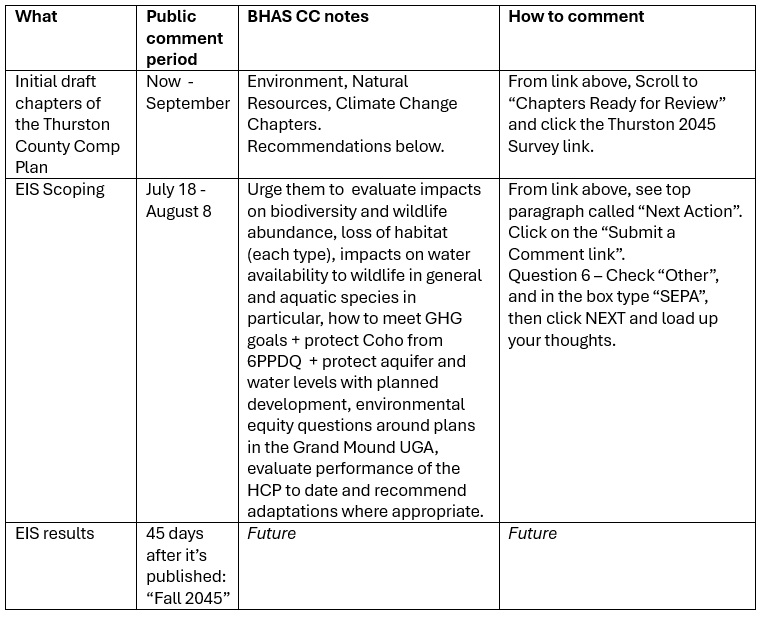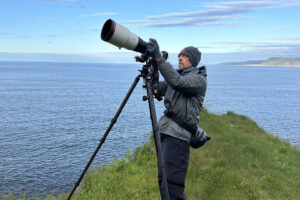Thurston County Comprehensive Plan – Update from the BHAS Conservation Committee
** See below for public comment info **
By Betsy Norton
Thurston County Comp Plan: The Thurston County Comprehensive Plan 2045 update is well underway. Initial outlines by county staff and discussions of draft chapters are proceeding with the TC Planning Commission through September. The Planning commission is listening, reading staff content and public comment, and discussing what will be included in their full plan proposal in the October/November timeframe.
Comp Plan Environmental Impact Statement (EIS): Thurston county has initiated a programmatic Supplemental Environmental Impact Statement (EIS) for the comp plan itself – an assessment of the plan’s likely impact to the natural and built environment, along with recommendations on updates to the proposed Comp plan to avoid negative impacts.
Right now, they are “scoping” the EIS – to determine what all it should cover – and there is public comment allowed here but the timeframe for submitting them is tight: July 18 – August 8. BHAS submitted brief comments on scoping at the 7/17 meeting.
Submitting Public Comment:
Your individual comments are just as important to help guide the Comp Plan. If you have 5 minutes to make your voice known on these subjects, please do!
Thurston County 2045 Comments: https://www.thurstoncountywa.gov/departments/community-planning-and-economic-development-cped/community-planning/thurston-2045
Note the time periods in the chart below for providing comments for the current and next stages of the Comp Plan development process.
BHAS Objectives:
These are a response to the 2 major threats to wildlife, climate change and habitat loss. The comp plan should protect not just people, but wildlife and the ecosystems that support both them and us.
- Protect Wildlife and Biodiversity
- Protect the number of species of wildlife and native flora
- Protect the abundance of species of wildlife and native flora
- Ensure the HCP is protecting ESA populations
- Protect resident and migrant species
- Conserve wildlife habitat
- Land – conserve natural habitat, reduce development footprints, reduce impervious surfaces
- Fresh Water – protect wetlands, streams, ponds, and lakes – beaver ponds especially
- Marine – clean up, restore marine environments, protect the shoreline habitat, esp. from sea level rise – avoid armoring
- Air – reduce light pollution and promote bird-friendly windows
- Connectivity – for species genetic strength
- Slow the advance of Climate Change
- Accelerate TC progress to meet GHG reduction goals – Climate commitments
- Reduce Vehicle Miles Travelled
- Preserve GHG reduction via carbon sequestration and carbon storage provided by conserved forests, prairies and wetlands
- Move towards fossil-free energy which is wildlife friendly (siting and operations)
- Increase Resilience to climate change
- Increase Habitat resilience to flooding and stormwater runoff. Retain [legacy] trees, reduce volume of impervious surfaces, build up stormwater systems to reduce runoff and filter out its pollutants (6-PPDQ), protect and encourage beaver dams, consider restoring historic floodplains
- Ensure continued wildlife access to sufficient water quantity and quality. Maintain sustainable levels of surface water and groundwater withdrawals to conserve water levels needed by wildlife in wetlands, streams, lakes and ponds during extended summers, Conserve [legacy] trees, forests and other ecosystem features that retain and protect water quality, keep its temperature down and slow its flow
- Provide habitat connectivity – for movement in response to climate change – Conserve appropriate habitat to connect terrestrial wildlife from the Cascades to the Olympics, support efforts to build wildlife corridor(s) across I-5, support efforts to enhance fish culverts to enable multiuse for other aquatic or terrestrial species
- Monitor, measure, assess effectiveness of conservation measures, enforce pollution laws
What we’ve done so far:
BHAS has been making suggestions, presenting testimony at Planning meetings and in writing, so that our perspective has been offered to the county for inclusion in their vision for the next 20 years. We have submitted comments regarding water, connectivity, EIS Scoping, natural resources, and are currently drafting comments on climate change and land use. For more information, or to view documents with these comments, please contact the Conservation Committee at conservationchair@blackhills-audubon.org .










